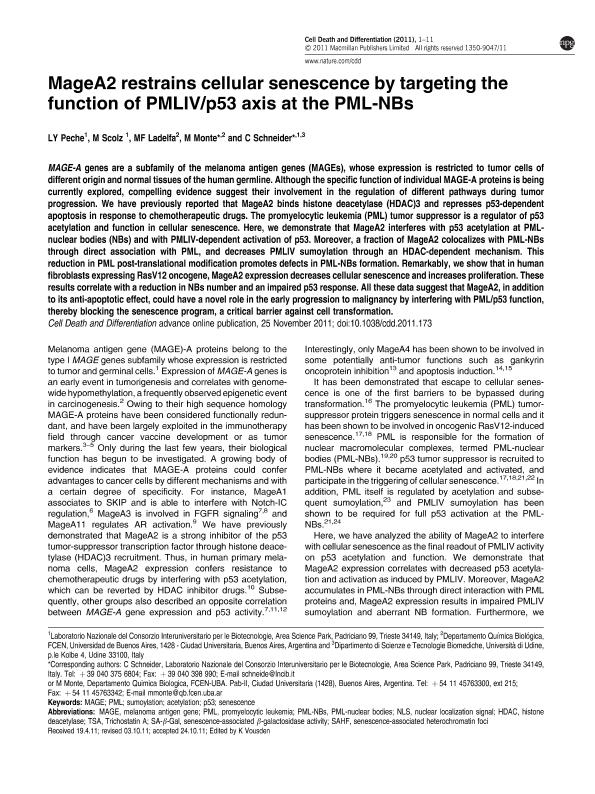Mostrar el registro sencillo del ítem
dc.contributor.author
Peche, L. Y.
dc.contributor.author
Scolz, M.
dc.contributor.author
Ladelfa, Maria Fatima

dc.contributor.author
Monte, Martin

dc.contributor.author
Schneider, C.
dc.date.available
2018-09-26T18:02:27Z
dc.date.issued
2012-06
dc.identifier.citation
Peche, L. Y.; Scolz, M.; Ladelfa, Maria Fatima; Monte, Martin; Schneider, C.; MageA2 restrains cellular senescence by targeting the function of PMLIV/p53 axis at the PML-NBs; Nature Publishing Group; Cell Death and Differentiation; 19; 6; 6-2012; 926-936
dc.identifier.issn
1350-9047
dc.identifier.uri
http://hdl.handle.net/11336/60923
dc.description.abstract
MAGE-A genes are a subfamily of the melanoma antigen genes (MAGEs), whose expression is restricted to tumor cells of different origin and normal tissues of the human germline. Although the specific function of individual MAGE-A proteins is being currently explored, compelling evidence suggest their involvement in the regulation of different pathways during tumor progression. We have previously reported that MageA2 binds histone deacetylase (HDAC)3 and represses p53-dependent apoptosis in response to chemotherapeutic drugs. The promyelocytic leukemia (PML) tumor suppressor is a regulator of p53 acetylation and function in cellular senescence. Here, we demonstrate that MageA2 interferes with p53 acetylation at PML-nuclear bodies (NBs) and with PMLIV-dependent activation of p53. Moreover, a fraction of MageA2 colocalizes with PML-NBs through direct association with PML, and decreases PMLIV sumoylation through an HDAC-dependent mechanism. This reduction in PML post-translational modification promotes defects in PML-NBs formation. Remarkably, we show that in human fibroblasts expressing RasV12 oncogene, MageA2 expression decreases cellular senescence and increases proliferation. These results correlate with a reduction in NBs number and an impaired p53 response. All these data suggest that MageA2, in addition to its anti-apoptotic effect, could have a novel role in the early progression to malignancy by interfering with PML/p53 function, thereby blocking the senescence program, a critical barrier against cell transformation. © 2012 Macmillan Publishers Limited. All rights reserved.
dc.format
application/pdf
dc.language.iso
eng
dc.publisher
Nature Publishing Group

dc.rights
info:eu-repo/semantics/openAccess
dc.rights.uri
https://creativecommons.org/licenses/by-nc-sa/2.5/ar/
dc.subject
Acetylation
dc.subject
Mage
dc.subject
P53
dc.subject
Pml
dc.subject
Senescence
dc.subject
Sumoylation
dc.subject.classification
Otras Ciencias Biológicas

dc.subject.classification
Ciencias Biológicas

dc.subject.classification
CIENCIAS NATURALES Y EXACTAS

dc.title
MageA2 restrains cellular senescence by targeting the function of PMLIV/p53 axis at the PML-NBs
dc.type
info:eu-repo/semantics/article
dc.type
info:ar-repo/semantics/artículo
dc.type
info:eu-repo/semantics/publishedVersion
dc.date.updated
2018-09-24T13:50:37Z
dc.journal.volume
19
dc.journal.number
6
dc.journal.pagination
926-936
dc.journal.pais
Reino Unido

dc.journal.ciudad
Londres
dc.description.fil
Fil: Peche, L. Y.. Laboratorio Nazionale del Consorzio Interuniversitario per le Biotecnologie; Italia
dc.description.fil
Fil: Scolz, M.. Laboratorio Nazionale del Consorzio Interuniversitario per le Biotecnologie; Italia
dc.description.fil
Fil: Ladelfa, Maria Fatima. Consejo Nacional de Investigaciones Científicas y Técnicas. Oficina de Coordinación Administrativa Ciudad Universitaria. Instituto de Química Biológica de la Facultad de Ciencias Exactas y Naturales. Universidad de Buenos Aires. Facultad de Ciencias Exactas y Naturales. Instituto de Química Biológica de la Facultad de Ciencias Exactas y Naturales; Argentina
dc.description.fil
Fil: Monte, Martin. Consejo Nacional de Investigaciones Científicas y Técnicas. Oficina de Coordinación Administrativa Ciudad Universitaria. Instituto de Química Biológica de la Facultad de Ciencias Exactas y Naturales. Universidad de Buenos Aires. Facultad de Ciencias Exactas y Naturales. Instituto de Química Biológica de la Facultad de Ciencias Exactas y Naturales; Argentina
dc.description.fil
Fil: Schneider, C.. Laboratorio Nazionale del Consorzio Interuniversitario per le Biotecnologie; Italia. Università di Udine; Italia
dc.journal.title
Cell Death and Differentiation

dc.relation.alternativeid
info:eu-repo/semantics/altIdentifier/doi/https://dx.doi.org/10.1038/cdd.2011.173
dc.relation.alternativeid
info:eu-repo/semantics/altIdentifier/url/https://www.nature.com/articles/cdd2011173
Archivos asociados
